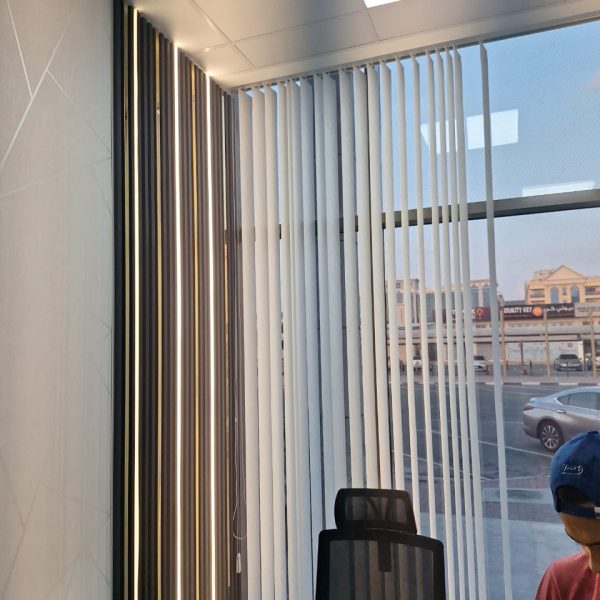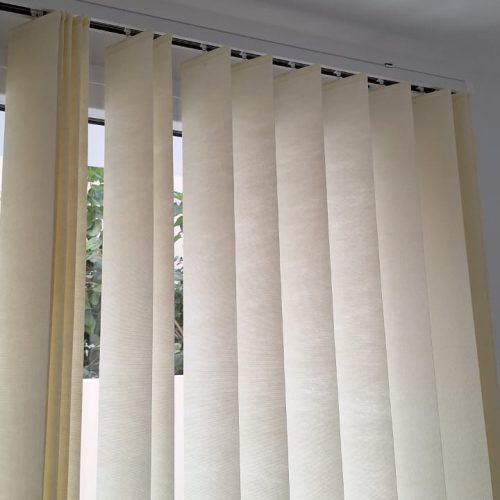Vertical Blinds: The Ultimate Guide for Your Home
Vertical blinds remain one of the most versatile window treatments—offering light control, privacy, and style. Whether you’re refreshing a single room or outfitting your entire home, this guide covers everything you need to know in 2025.
1. How to Choose the Right Vertical Blinds for Your Room
- Measure Precisely
- Width: Add 2–3 cm extra on each side to block light gaps.
- Height: Measure from top of the frame to the floor or sill.
- Consider Room Function
- Living Areas: Fabric vanes in rich textures.
- Bathrooms/Kitchens: PVC or moisture-resistant aluminum.
- Match Your Décor
- Neutral tones for minimalism.
- Bold patterns or colors as focal points.
- Control Options
- Chain Control: Traditional and budget-friendly.
- Corded/Wand Control: Smooth operation for large windows.
- Motorized: Smart-home integration for hard-to-reach windows.
2. Are Vertical Blinds Good for Small Spaces?
- Space-Saving Design
- Slender vertical vanes take up minimal headrail space.
- Visual Height Boost
- Vertical lines draw the eye up, making low ceilings feel taller.
- Light Control
- Partially tilt to let in light without sacrificing privacy—ideal for compact living rooms or bedrooms.
3. Best Fabrics and Materials for Vertical Blinds
| Material | Pros | Cons | Recommended Use |
|---|---|---|---|
| PVC | Waterproof, easy to wipe clean | Can feel less luxurious | Bathrooms, kitchens |
| Polyester Fabric | Wide color/pattern options, soft texture | May require gentle cleaning | Living rooms, bedrooms |
| Aluminum | Durable, sleek, flame-retardant | Colder aesthetic | Offices, minimalist interiors |
| Faux-Wood | Moisture-resistant, wood look for less cost | Heavier slats | Bathrooms, high-moisture areas |
4. How to Install Vertical Blinds in Simple Steps
- Gather Tools: Drill, screws, level, pencil, measuring tape.
- Mark Bracket Positions: Inside or outside mount—use a level.
- Drill Pilot Holes: Prevents frame damage.
- Attach Brackets: Secure at marked spots.
- Snap in Headrail: Ensure it clicks firmly.
- Hang Vanes: Slide each vane into its carrier clip.
- Test Operation: Rotate and draw fully open/closed.
Pro Tip: If you’re unsure, order a sample vane first to check color and opacity.
5. How to Install Vertical Blinds by Yourself
- Skill Level: Easy for anyone comfortable with a drill.
- Time Required: 30–60 minutes for a standard window.
- Video Resources: Many manufacturers provide step-by-step online tutorials.
6. How to Change the Slats in Your Vertical Blinds
- Open Headrail Cover: Gently pry off the front flap.
- Release Vanes: Push each carrier clip sideways.
- Attach New Vanes: Slide into clip until you hear a click.
- Close Headrail Cover: Ensure it snaps back into place.
Note: Keep old slats as spares—perfect for quick repairs.
7. Quick Ways to Clean and Maintain Vertical Blinds
- Weekly Dusting: Use a microfiber cloth or handheld vacuum attachment.
- Spot Cleaning:
- Fabric: Mild detergent and a damp cloth.
- PVC/Aluminum: All-purpose cleaner sprayed on cloth, not directly on the blinds.
- Deep Clean (Monthly): Remove all vanes and soak fabric slats in lukewarm soapy water; rinse and air-dry fully before rehanging.
8. Top Tips to Keep Your Vertical Blinds Looking New
- Rotate Vanes Regularly: Prevents permanent creasing on fabrics.
- Avoid Harsh Chemicals: They can damage coatings on PVC and aluminum.
- Check Mechanisms: Lubricate tracks with a silicone-based spray if you hear squeaks.
9. Fixing Common Problems with Vertical Blinds
- Vanes Won’t Rotate:
- Clean headrail track of dust/debris.
- Inspect and replace bent carrier clips.
- Vanedrops from Headrail:
- Ensure clips fully engage.
- Replace worn-out clips—available from most blind suppliers.
- Sticking or Jamming:
- Realign headrail using gentle taps with a rubber mallet.
- Apply a dry silicone spray to the track.
10. How to Keep Your Vertical Blinds from Falling Down
- Use End Caps: Secure the last vane to prevent slippage.
- Choose Quality Tracks: Heavier-duty headrails hold slats firmly.
- Professional Installation: Guarantees correct bracket alignment.
11. Can Vertical Blinds Block Out Sunlight?
- Blackout Fabrics: Completely block UV and glare—ideal for media rooms.
- Opaque PVC/Aluminum: Offer near-total blockage when closed fully.
- Light-Filtering Fabrics: Let in diffused light without direct glare.
12. Stylish Ideas to Decorate with Vertical Blinds
- Layering: Pair with sheer panels or drapes for depth and texture.
- Accent Slats: Alternate two complementary colors for a modern look.
- Pattern Play: Geo-prints or botanicals in light tones add character.
13. Best Colors and Styles for Vertical Blinds in 2025
- Soft Pastels: Mint green, blush pink for Scandinavian interiors.
- Earthy Neutrals: Terracotta, warm greys in biophilic design.
- Matte Black or Navy: Striking contrast in industrial or modern loft styles.
14. Costs and Savings When Buying Vertical Blinds
| Feature | Budget Range (AED) | Premium Range (AED) | Savings Tip |
|---|---|---|---|
| Standard PVC Slats | 50 – 100 per m² | N/A | Bulk orders often ≥ 10 % off |
| Fabric Vertical Blinds | 120 – 200 per m² | 200 – 350 per m² | Opt for off-white neutrals |
| Motorized Opener Kit | 600 – 900 total | 900 – 1,500 total | DIY install to save labor |
| Installation Service | 100 – 200 per window | 200 – 350 per window | Bundle multiple windows |
Tip: Many suppliers offer free consultation and measurement in Dubai—leverage this to avoid costly mistakes.
15. Why Vertical Blinds Are a Cheap Way to Dress Up Your Windows
- Affordable Materials: PVC and polyester keep costs down.
- Longevity: Durable vanes rarely need replacement—low lifetime cost.
- DIY-Friendly: No need to hire expensive installers if you follow simple guides.
Frequently Asked Questions (FAQs) about Vertical Blinds
1. Which Vertical Blinds Work Best for Bright Rooms?
Light-filtering sheer polyester or sunscreen PVC vanes in pale colors (cream, soft gray) diffuse glare while preserving natural light and reflecting heat to protect furnishings.
2. What Are the Top Choices for Childproof Vertical Blinds?
Opt for cord-free tilt wands or motorized controls, heavy-duty PVC slats, and snap-in carriers to eliminate dangling hazards and allow easy replacement of any damaged vane.
3. Which Vertical Blinds Offer the Best Privacy and Light Control?
Choose blackout fabrics, wide vanes (127 mm+), and side-channel tracks. This combination blocks nearly 100% of daylight, seals out gaps, and prevents outside views into your room.
4. How Do I Pick Durable Vertical Blinds for Busy Homes?
Look for commercial-grade aluminum headrails, thick vinyl slats, reinforced carriers, and rust-resistant hardware—ideal for high-traffic areas like kitchens and living rooms.
5. Which Vertical Blinds Are Budget-Friendly Yet Stylish?
Basic PVC slats (under AED 25/m²) in textured finishes, entry-level polyester fabrics (~AED 30–40/m²), and off-the-shelf sizes deliver an upscale look without custom fees.
6. Which Vertical Blinds Are Easiest to Clean and Maintain?
Smooth vinyl or aluminum slats wipe clean with a damp cloth; mold-resistant fabrics repel mildew; and quick-release carriers let you pop off vanes for soaking and rinsing.
7. Which Vertical Blinds Help Keep Your Room Cooler?
Thermal-backed or honeycomb-insert slats trap air for insulation (up to 15% energy savings), reflective inner coatings bounce infrared rays, and inside-mount installs minimize gaps.
8. What Are Slim Vertical Blinds for Small Spaces?
Look for 89 mm slats in lightweight fabrics that fold compactly, paired with an outside mount to visually enlarge narrow windows without overwhelming the space.
9. Which Vertical Blinds Work Best for Large Windows and Sliding Doors?
Panel-track systems with 250–400 mm panels on reinforced rails or motorized options simplify operation across wide spans, and heavy-duty headrails prevent sagging.
10. Which Vertical Blinds Are Best for Slanted Ceilings?
Custom-angled headrails with flexible carriers, using lightweight fabrics or thin aluminum vanes, ensure smooth tracking along non-standard slopes and arches.
11. How Do I Pick the Right Vertical Blinds for Small Windows?
Measure precisely, choose inside mounts for minimal frame exposure, and opt for lighter hues and narrower vanes to keep the room bright and airy.
12. Which Vertical Blinds Block Noise and Sunlight Most Effectively?
Thick blackout polyester or PVC slats, overlapping wide vanes, and side-channel seals combine to muffle sound and eliminate light leaks for maximum comfort.
13. What Are Stylish Vertical Blinds for Modern Homes?
Matte-finish slats in graphite, slate, or ivory; concealed headrails for a floating effect; and subtle textured weaves or pinstripes add contemporary flair without visual clutter.
14. Which Vertical Blinds Are Best for Kids’ Rooms?
Choose vibrant fabrics or playful print panels, quiet carrier mechanisms to reduce clatter, and cord-tuck systems or wand-only controls to keep little hands safe.
15. Which Vertical Blinds Offer the Best Light and Heat Control?
Combine reflective-backed vanes with honeycomb inserts for superior insulation and glare reduction; add side seals to completely block midday sun and maintain a comfortable temperature.
16. What Are the Most Colorful Vertical Blinds for Any Style?
Conclusion
Whether you need blackout privacy, child-safe operation, energy savings, or a modern statement piece, there’s a vertical blind solution tailored to your home and lifestyle. From budget-friendly PVC options to premium motorized systems, choosing the right material, style, and installation method will ensure lasting performance and satisfaction.
📞 Chat on WhatsApp: +971 52 791 5772
📧 Email: [email protected]
🌐 Website: www.curtainfix.com


